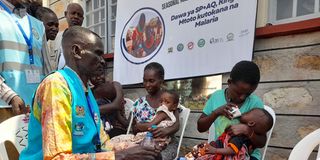New prevention campaign reduces malaria cases by 70 per cent

Mr Joshua Ebei, a Community Health Promoter, administerers sulfadoxine-pyrimethamine + amodiaquine doses to children in Kanam Kemer, Turkana Central Sub-county on June 18, 2024.
What you need to know:
- The programme surpassed the target of 38,585 children aged between three to 59 months by reaching 40,123 children.
Kenya’s first-ever Seasonal Malaria Chemoprevention (SMC) pilot project that was conducted in Turkana Central has demonstrated that it can prevent malaria infection rate in children by up to 70 per cent.
The pilot project was conducted between June to October 2024, signaling a potential breakthrough in the fight against malaria, a life-threatening disease caused by parasites transmitted through the bite of an infected mosquito.
The World Health Organization defines SMC as the intermittent administration of a curative dose of antimalarial medicine to children regardless of whether they are infected with malaria or not.
The National Malaria Control Programme first singled out Turkana Central as a high disease burden sub-county. Research established that seasonality of malaria cases peak from May to September.
Turkana County government, Catholic Relief Services and Moi University in conjunction with Duke University in North Carolina, United States, rolled out the SMC programme to test its effectiveness in the sub-county.
Dr Joseph Lenai, director of Primary Health Care in the Ministry of Health, said the programme surpassed the target of 38,585 children aged between three to 59 months by reaching 40,123 children.
The project was implemented in five cycles, each coming up after 28 days. The children were administered a combination of sulfadoxine-pyrimethamine and amodiaquine.
Prof Wendy O’Meara of Duke University, a lead researcher, reported that 97 per cent of children were reached with at least one cycle, 12 per cent experienced side effects that included persistent vomiting while others were too weak after the dose. The cases were referred to local dispensaries, where the children were treated.
"Challenges that related to data entry, weather conditions and logistics in remote areas saw only 27,208 children completing all the five cycles. But after analysing data, it was established that the programme worked because it reduced malaria cases by up to 71 per cent," Dr Lenai said.
He said the success of the pilot programme was similar to its progress in countries such as Nigeria and Guinea that had already rolled it out before the World Health Organization said it could be adopted by other countries.
Dr Lenai added that SMC will be included in the new malaria policy and strategy to ensure budgetary allocations and resource mobilisation for the programme.
"Preliminary results show that this is the way to go and at the national level, we will continue with the technical support to county governments, help in resource mobilisation and cement the coordination," Dr Lenai said as he urged Turkana County government to scale up to other sub-counties, and other counties across the country to embrace it.
He, however, called for cost analysis research to better understand the economic benefits of the prevention method.
Dr Edwin Mbugua, head of Health Nutrition and Social Services at Catholic Relief Services, said they are committed to support the national government and Turkana County to continue to generate evidence on SMC and to use that evidence to advocate for more resources so that the programme can be scaled up across the country.
He said SMC can benefit Kenyans in terms of reducing the disease burden on health systems and economic burden linked to treatment of malaria as the intervention directly benefits communities, especially those that are vulnerable and living in marginalised areas.
Turkana County Health Executive Joseph Epem said the county stands to benefit from the new prevention strategy because the county malaria prevalence rate is 30 per cent compared to the national prevalence rate of six per cent.
"Malaria also accounts for over 30 per cent of hospital admissions in our hospitals and is the leading cause of illness in the county. The findings of this case study are more consistent with data from areas where it is being implemented in the Sahel region of Guinea and Nigeria. We will scale up SMC to reduce the disease burden," Dr Epem said.
Turkana Deputy Governor John Erus said that if adopted by devolved units across the country, it will not only reduce the cost in healthcare in terms of malaria management and interventions but also save lives.





